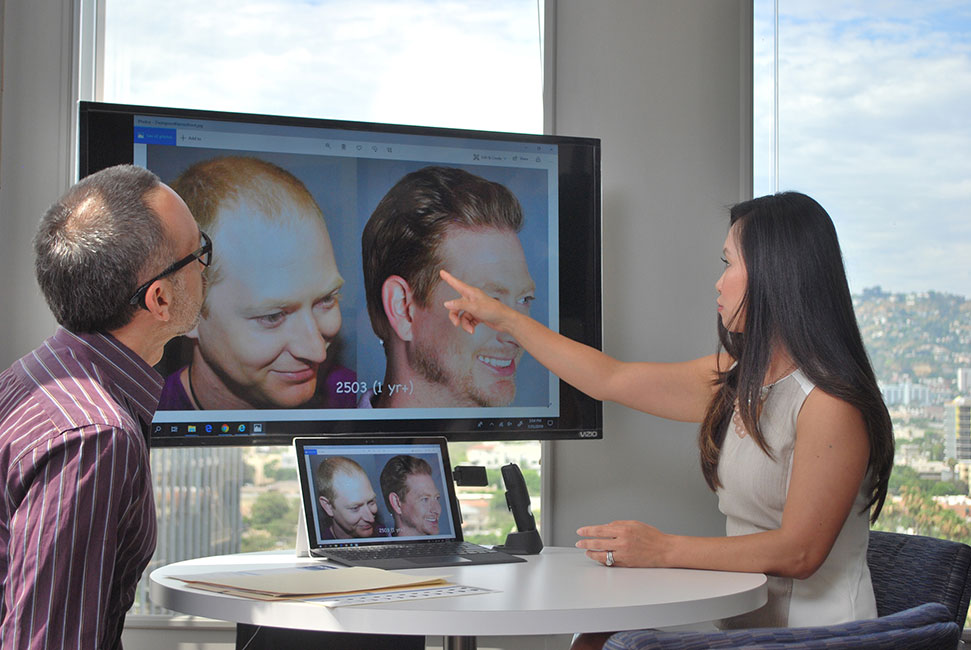Do I need to do anything ahead of time to prepare for my consultation?
To make the most of your consultation, we kindly ask you to complete the intake form ahead of your consultation. The link is enclosed in your consultation confirmation and reminders. For non-English speakers, please note, these forms, along with the rest of your medical record is in English, so if necessary, please have someone assist you with filling out these forms accurately in English.
Can I bring someone with me to the consultation?
Of course, having someone you trust with you, can help you reinforce your decision on whether or not hair restoration is right for you. We find that when a patient involves a friend or family member in the consultation process, it helps patients decide which path is right for them.
Interpretation / Language Assistance
If necessary, interpretation services will be provided for you at no cost. Please let our patient care center know your needs ahead of time (call 888-888-8888 or email [email protected]), so we can arrange for an interpreter in advance of your consultation. You are more than welcome to have someone interpret for you (friend, family member, etc). Bring someone that can interpret for you can enhance your consultation experience even further and contribute to a more positive and seamless discussion. Note: Bosley informational sheets are only provided in English or Spanish.
If you decide to have a medical procedure, you might wonder if you will need an interpreter that day too. In most cases, if Spanish if your preferred language, having an interpreter for your medical procedure is unnecessary as most of our medical teams have at least one member who can speak Spanish and will be able to assist you effectively throughout the process. If another language is requested, and you are unable to bring someone that can help interpret for you, then our team can arrange an interpreter for you.
How long will the consultation last?
Consultations typically last around 30 minutes, although they may go longer depending on your questions, goals and any specific needs. We understand that choosing to restore your hair is a significant decision and we want to ensure that you have all the time you need to make get the information you desire. Your Bosley Counselor is prepared to give you the attention and support you need throughout the consultation process.
Consultation Consideration – Quiet Room
It is highly recommended to find a quiet location where you can have a conversation with your Bosley Counselor. This will allow you to give your full attention, and if necessary, comfortably discuss any information relevant to your goals.
What platform will be used for my video consultation?
Zoom is our preferred platform for video consultations. Zoom allows us to provide you with multi-media visual aids, ensuring an enhanced and tailored consultation experience. If you don't have Zoom, we highly recommend downloading the Zoom app to your phone or computer, or you can access the Zoom website on a computer (laptop or desktop) without the need for any download (https://zoom.us/join). If utilizing Zoom is not feasible, upon request, we can also conduct the consultation through Facetime, WhatsApp, or Google Meet. If desired, please let our patient care center know your needs ahead of time by calling 888-888-8888 or emailing [email protected].
Will I have to provide pictures of myself?
Yes, your Senior Counselor will request pictures taken from specific angles. These "before" pictures will be confidentially stored in your private medical chart and will not be shared with anyone outside the team providing your care. To streamline the process, we recommend taking these photos in advance, so you can easily share them with your Senior Counselor when requested.

We hope these answers have given you a clear understanding of what to expect during your consultation with Bosley. Our team is dedicated to supporting you every step of the way as you embark on your hair restoration journey. Remember, your consultation is a crucial part of this process, and we are here to provide you with the personalized care and guidance you deserve.
Get ready to take the first step towards a fuller head of hair. We look forward to seeing you!







